Als u last heeft van pop-ups in Windows 10, dan is het sterk afhankelijk van wat voor type pop-ups.
Er kunnen pop-ups worden getoond door de browser, recente geïnstalleerde apps, malware of door functies in Windows 10 zelf.
Als er pop-ups door de browser worden getoond, dan is dit vaak te herkennen aan pop-ups die rechtsonderin bij de tijd en datum worden getoond. Dit type pop-ups promoot over het algemeen online diensten, onbekende websites etc. Dit gaat meestal gepaard met een pictogram die herkenbaar is als browser. Bijvoorbeeld een Google Chrome pictogram.
Meld u dan aan voor onze nieuwsbrief.
Applicaties die in Windows 10 worden uitgevoerd, kunnen pop-ups weergeven om de gebruiker te waarschuwen voor meldingen, zoals nieuwe e-mails, chatberichten, afspraken, enz. Het gaat dan om recent geïnstalleerde apps die toestemming is gegeven om meldingen te mogen versturen. Dit type meldingen wordt ook wel pop-ups genoemd, maar het zijn normale Windows 10 meldingen, die meestal geen kwaad kunnen.
Als laatste zijn er nog pop-ups die worden verstuurd door het besturingssysteem zelf. Windows 10 kan pop-ups weergeven om de gebruiker op de hoogte te stellen van belangrijke systeemupdates, beveiligingswaarschuwingen, waarschuwingen voor lage batterij, enz. De meest vervelende pop-ups zijn vaak pop-ups die diensten van Microsoft promoten. Denk hierbij aan pop-ups die korting bieden voor Azure cloud of Office 365.
In deze gids gaan we alle instellingen na om pop-ups in Windows 10 uit te schakelen.
Vervelende pop-ups blokkeren in Windows 10
Browser pop-ups blokkeren
We gaan beginnen met het controleren op pop-ups die verstuurd worden via de browser. Dit noemen we voor het gemak even “pop-ups”, maar in werkelijkheid zijn het meldingen.
Afhankelijk van welke standaard browser u gebruikt, volgt u de onderstaande stappen.
Google Chrome
- Open de Chrome browser.
- In de adresbalk type: chrome://settings/content/notifications/
- Om pop-ups te blokkeren, schakelt u de optie “Niet toestaan dat sites meldingen sturen” in.
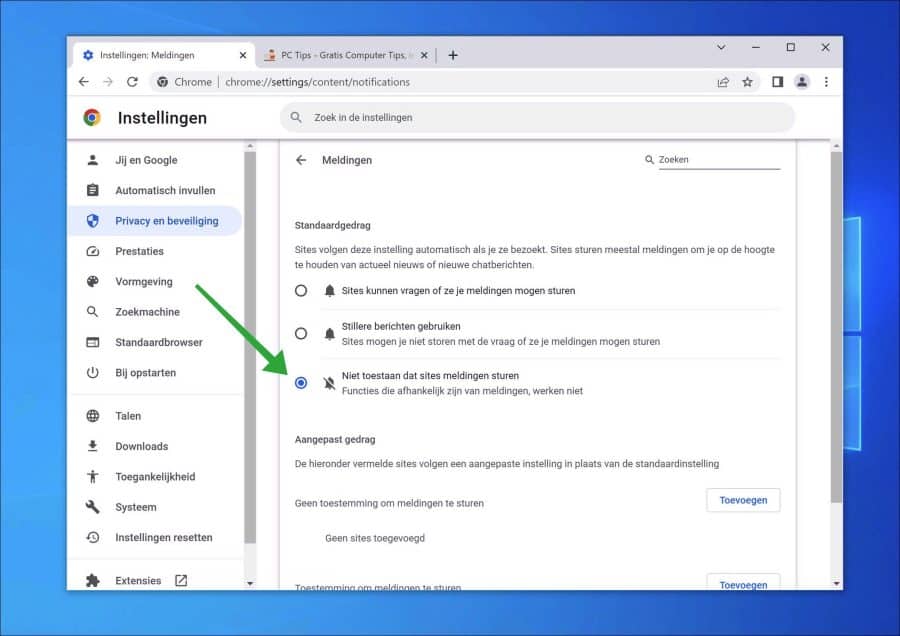
Microsoft Edge
Om meldingen uit te schakelen volgt u onderstaande stappen.
- Open de Microsoft Edge browser.
- In de adresbalk type: edge://settings/content/notifications/
- Schakel de optie “Altijd vragen voordat gegevens worden verzonden (aanbevolen)” uit.
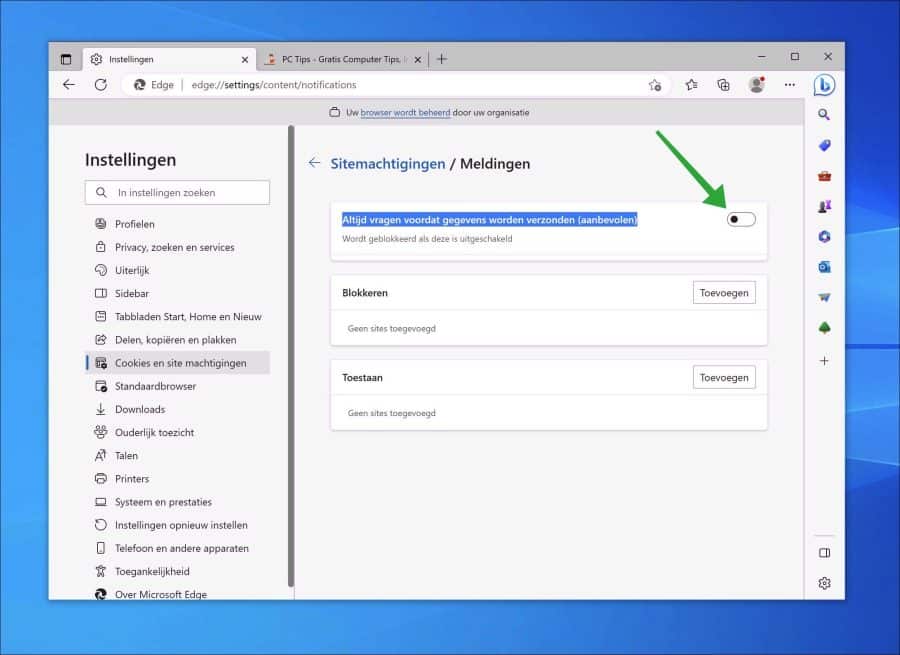
Om pop-ups uit te schakelen volgt u onderstaande stappen.
- Open de Microsoft Edge browser.
- In de adresbalk type: edge://settings/content/popups/
- Schakel de optie “Blokkeren (aanbevolen)” in.
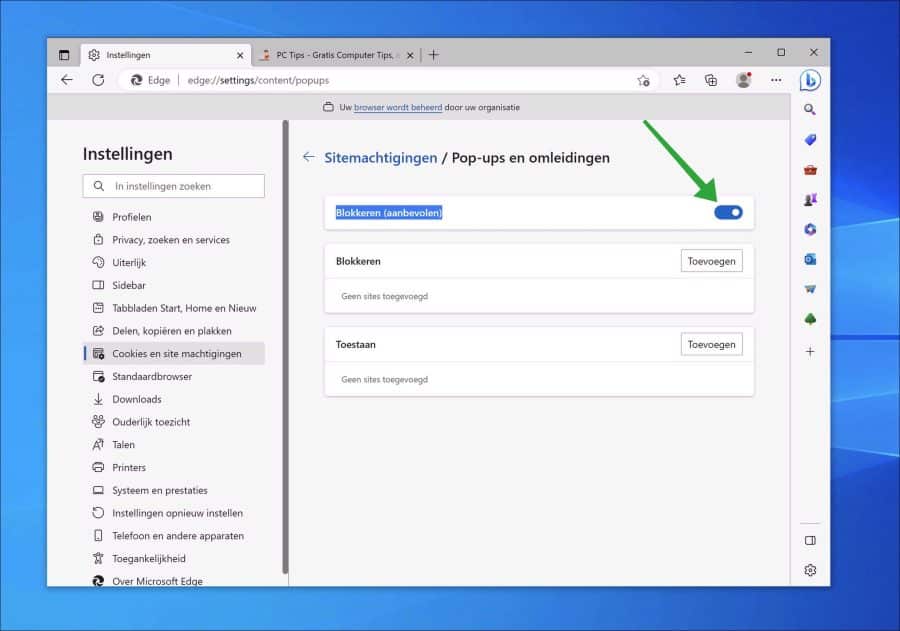
Applicatie pop-ups blokkeren
Als u pop-ups ontvangt van apps van derden dan kunt u dit type ook blokkeren. Dit kunt u doen via de Windows instellingen.
- Open de Windows instellingen.
- Klik op “Systeem”.
- Klik op “Meldingen en acties”.
- Schakel de optie “Meldingen van apps en andere afzenders ontvangen” uit.
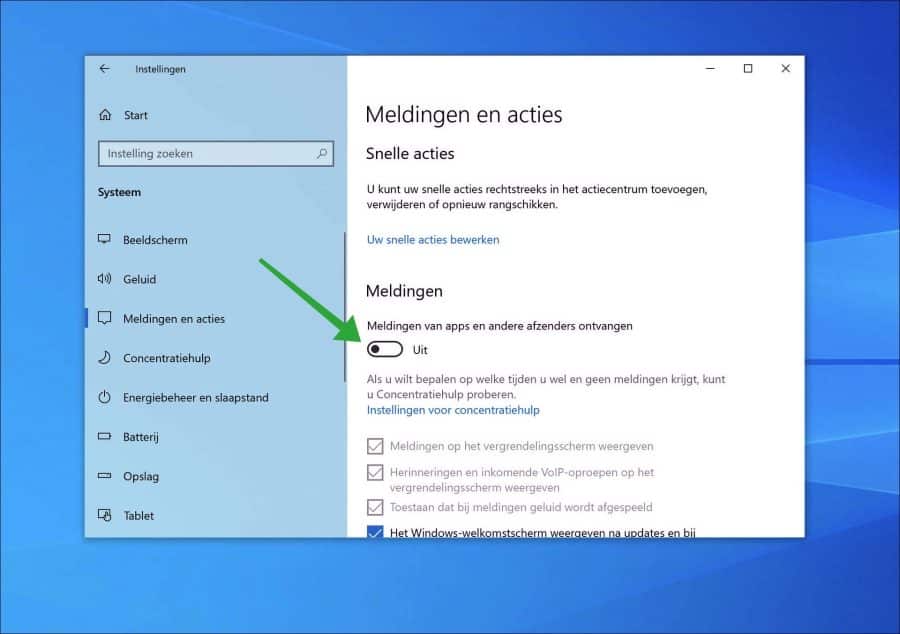
Windows 10 systeem pop-ups blokkeren
U kunt verschillende pop-ups die door Windows 10 worden verzonden blokkeren. Dit zijn Startmenu pop-ups, Windows verkenner pop-ups, vergrendelscherm pop-ups en Windows update pop-ups. We gaan ze allemaal langs. Op deze manier kunt u een keuze maken of u dit type systeem pop-up wel of niet wilt tonen.
- Open de Windows instellingen.
- Klik op “persoonlijke instellingen”.
- Klik op “Startmenu”.
- Om suggesties zoals pop-ups in het Start menu uit te schakelen, schakelt u de optie “Af en toe suggesties in Start weergeven” uit.
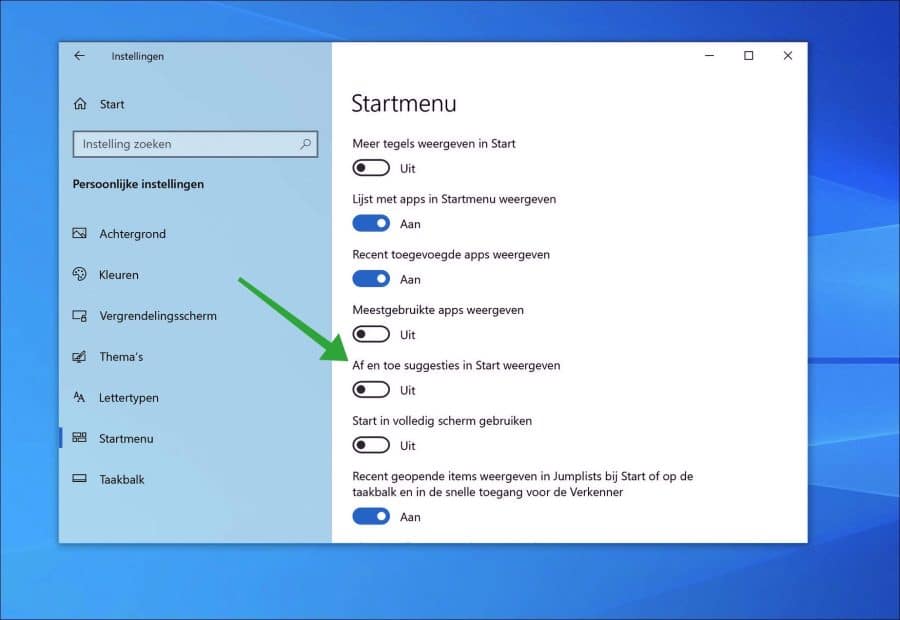
Windows verkenner pop-ups uitschakelen
Synchronisatieprovider meldingen lijken op pop-ups. Het zijn meldingen over de synchronisatiestatus van uw Microsoft account. Wanneer u deze optie is ingeschakeld, krijgt u meldingen over wijzigingen die zijn aangebracht in uw Microsoft account, zoals nieuwe e-mails, agenda-afspraken, contacten en andere informatie die is gekoppeld aan uw account. Het uitschakelen van synchronisatieprovider stopt dit type meldingen.
- Open de Windows verkenner.
- Klik in het lint op “beeld”.
- Klik op “Opties”.
- In de mapopties klik op tabblad “Weergave”.
- Schakel de optie “Meldingen weergeven van synchronisatieprovider” uit.
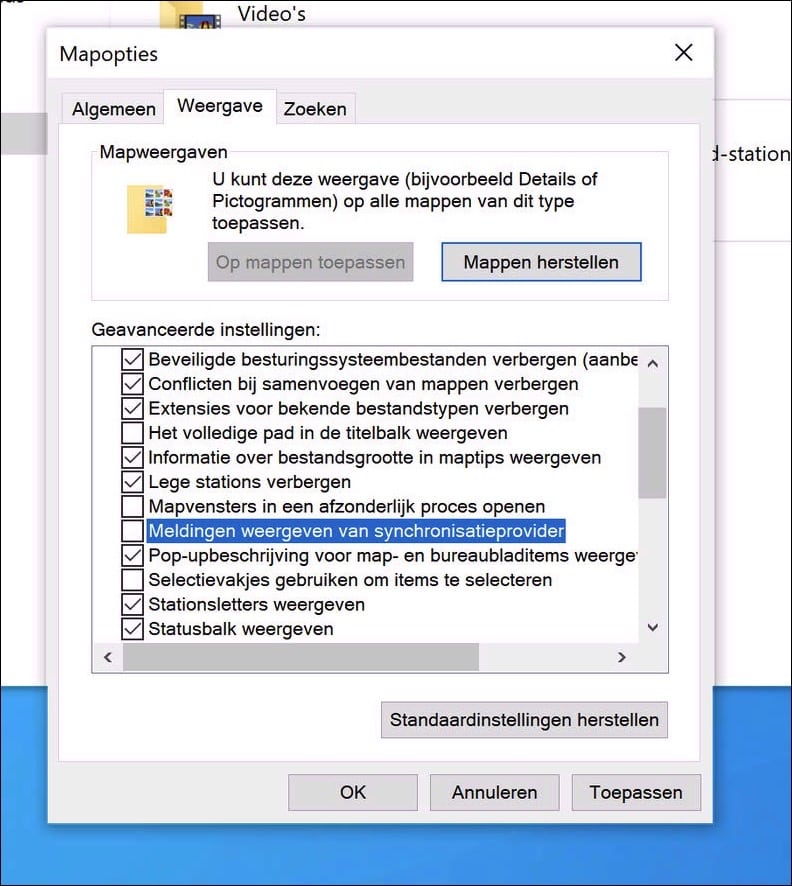
Vergrendelscherm pop-ups uitschakelen
Ook op het vergrendelscherm wordt reclame getoond. Dit zijn weetjes, tips en meer over Windows of Cortana. Als u dit type reclame niet wilt ontvangen dan kunt u het uitschakelen.
- Open de Windows instellingen.
- Klik op “persoonlijke instellingen”.
- Klik op “Vergrendelingsscherm”.
- Schakel de optie “Leuke weetjes, tips en meer over Windows en Cortana op uw vergrendelingsscherm weergeven” uit.
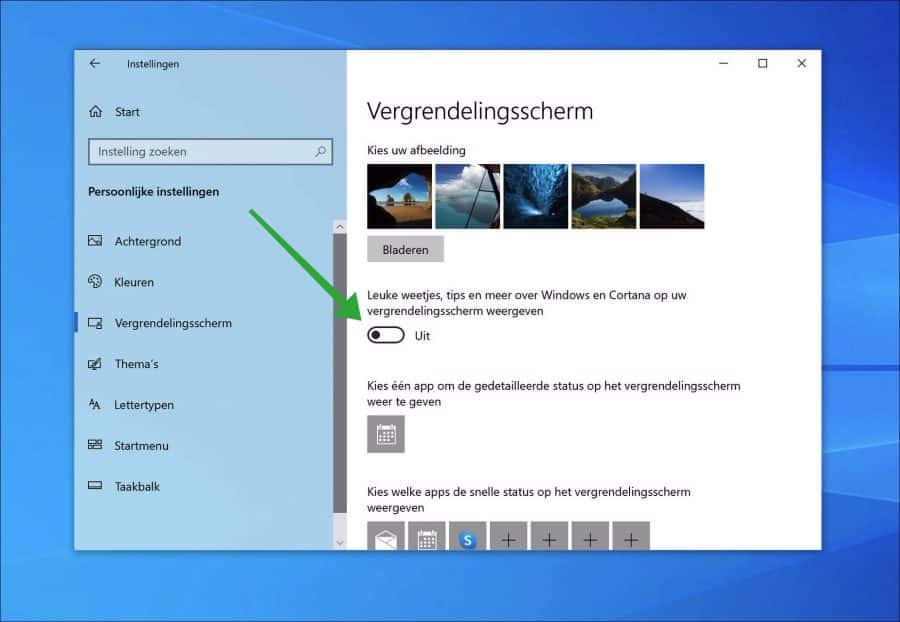
Windows update pop-ups uitschakelen
Het laatste type pop-ups waar veel mensen zich aan storen zijn de pop-ups m.b.t. Windows update. Dit zijn pop-ups dat er nieuwe updates beschikbaar zijn, maar ook pop-ups dat uw computer herstart moet worden om de updates te voltooien. Dit soort pop-ups kunt u uitschakelen.
- Open de Windows instellingen.
- Klik op “Bijwerken en beveiliging”.
- Klik op “Windows update”.
- Klik op “Geavanceerde opties”.
- Schakel de optie “Meldingen van updates” uit.
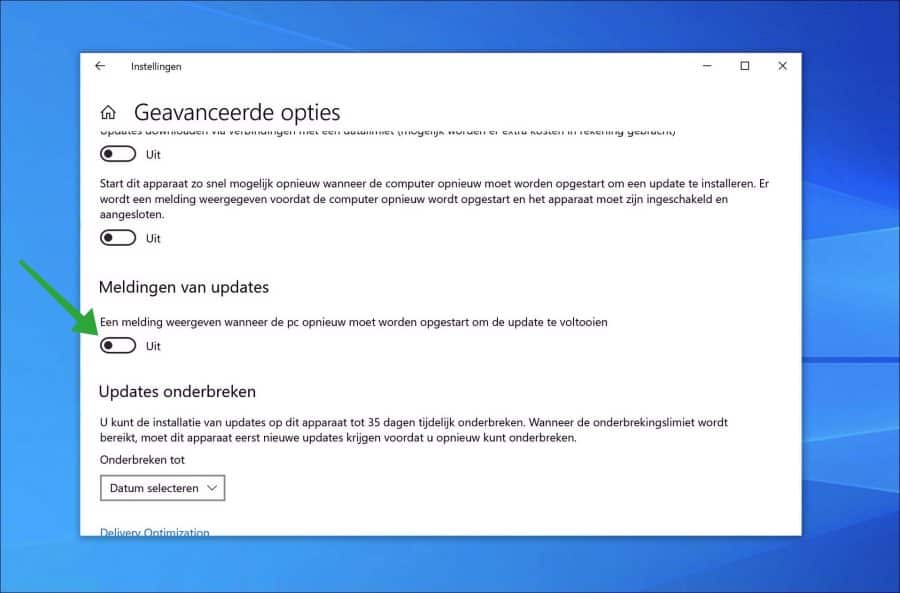
U heeft nu alle instellingen nagelopen die vanuit Windows 10 pop-ups kunnen tonen. Als u nog steeds pop-ups ervaart waarvan u geen idee heeft waar ze vandaan komen, stel dan u vraag onderaan via het commentaar veld.
Ik raad u echter aan voordat u een vraag stelt om uw computer te controleren op malware met Malwarebytes. Op deze manier weet u zeker dat de pop-ups niet worden veroorzaakt door eventuele malware op uw computer.
Ik hoop u hiermee geholpen te hebben. Bedankt voor het lezen!


Help mee
Mijn computertips zijn gratis en bedoeld om andere mensen te helpen. Door deze pc-tip te delen op een website of social media, helpt u mij meer mensen te bereiken.Overzicht met computertips
Bekijk ook mijn uitgebreide overzicht met praktische computertips, overzichtelijk gesorteerd per categorie.Computerhulp nodig?
Loopt u vast met uw pc, laptop of software? Stel uw vraag op ons computerforum en krijg gratis computerhulp van ervaren leden en experts.